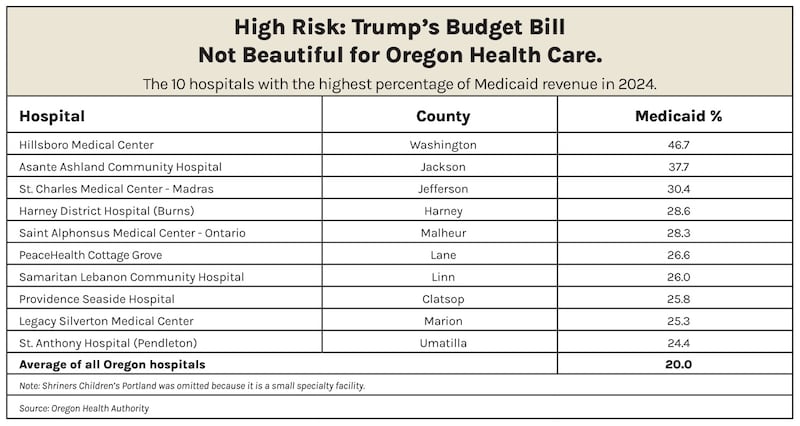This story was produced by the Oregon Journalism Project, a nonprofit newsroom covering the state.
When President Donald Trump signed the “One Big Beautiful Bill” into law on July 4, every hospital CEO in Oregon got heartburn. That’s because the bill focused heavily on cuts to Medicaid, the health insurance program for low-income Americans called the Oregon Health Plan here.
Estimates from Princeton University indicate that about 11% of Medicaid enrollees nationally could be impacted in the next year. In Oregon it could be as much as 20% because the state has aggressively pursued federal dollars for OHP for 30 years.
In 2023, the last year for which the feds have published data, 33.6% of Oregonians were on Medicaid—well above the 27.7% median for all states. Therefore the cuts will fall disproportionately hard on Oregon.
“This is not what Oregonians asked for,” state Sen. Deb Patterson (D-Salem), chair of the Senate Committee on Health Care, said in a statement after the bill passed. “This Big Brutal Bill may look like a win for corporations, but it is a direct attack on the health and dignity of Oregon families.”
Hospitals, particularly in rural Oregon, will face a double whammy. All hospitals depend on Medicaid payments for a substantial portion of their revenue, and when patients lose Medicaid coverage, hospitals still have to serve them because of federal requirements. The Hospital Association of Oregon says its members get only about 56 cents per dollar of expense from OHP—but that’s better than nothing.
In 2024 Medicaid payments made up 20% of revenue for an average hospital in the state (see chart below). That figure approached 50% for Hillsboro Medical Center last year.
Remote hospitals with fewer than 25 beds receive extra funds for Medicaid services. But even with these supplements, the Hospital Association says most Oregon hospitals lost money in 2024. In Patterson’s estimation, the Big Beautiful Bill is likely to make matters worse.
“Oregon families, seniors and rural communities will be left to pay the price,” she said.

This reporting is supported by the Heatherington Foundation for Innovation and Education in Health Care.

